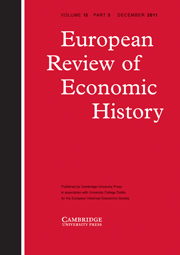Crossref Citations
This article has been cited by the following publications. This list is generated based on data provided by
Crossref.
O'Rourke, Kevin H.
1998.
Culture, Malthus, and Irish Demographic History.
The Journal of Economic History,
Vol. 58,
Issue. 3,
p.
862.
Dribe, Martin
2003.
Migration of rural families in 19th century southern Sweden. A longitudinal analysis of local migration patterns.
The History of the Family,
Vol. 8,
Issue. 2,
p.
247.
Oris, Michel
2003.
The history of migration as a chapter in the history of the European rural family: An overview.
The History of the Family,
Vol. 8,
Issue. 2,
p.
187.
Oxley, Deborah
2004.
Living Standards of Women in Prefamine Ireland.
Social Science History,
Vol. 28,
Issue. 2,
p.
271.
Gráda, Cormac Ó
2004.
INTRODUCTION1.
Food and Foodways,
Vol. 12,
Issue. 2-3,
p.
69.
Woodward, Nicholas
2006.
Transportation Convictions during the Great Irish Famine.
The Journal of Interdisciplinary History,
Vol. 37,
Issue. 1,
p.
59.
Ó Gráda, Cormac
2007.
Making Famine History.
Journal of Economic Literature,
Vol. 45,
Issue. 1,
p.
5.
Smith, Malcolm T.
and
Macraild, Donald M.
2009.
Nineteenth‐century population structure of Ireland and of the Irish in England and Wales: An analysis by isonymy.
American Journal of Human Biology,
Vol. 21,
Issue. 3,
p.
283.
Dribe, M.
2009.
Demand and supply factors in the fertility transition: a county-level analysis of age-specific marital fertility in Sweden, 1880-1930.
European Review of Economic History,
Vol. 13,
Issue. 1,
p.
65.
Curran, Declan
and
Fröling, Maria
2010.
Large-scale mortality shocks and the Great Irish Famine 1845–1852.
Economic Modelling,
Vol. 27,
Issue. 5,
p.
1302.
Goodspeed, Tyler Beck
2012.
Famine, Finance, and Adjustment to Environmental Shock: Microcredit and the Great Famine in Ireland.
SSRN Electronic Journal,
Brata, Aloysius Gunadi
Rietveld, Piet
de Groot, Henri L.F.
and
Zant, Wouter
2013.
The Krakatau Eruption in 1883: Its Implications for the Spatial Distribution of Population in Java.
Economic History of Developing Regions,
Vol. 28,
Issue. 2,
p.
27.
Fussell, Elizabeth
2013.
The Encyclopedia of Global Human Migration.
Bandiera, Oriana
Rasul, Imran
and
Viarengo, Martina
2013.
The Making of Modern America: Migratory Flows in the Age of Mass Migration.
Journal of Development Economics,
Vol. 102,
Issue. ,
p.
23.
Ofer, Inbal
2015.
Identity and Migration in Europe: Multidisciplinary Perspectives.
Vol. 13,
Issue. ,
p.
149.
Voutilainen, Miikka
2015.
Malthusian checks in pre-industrial Sweden and Finland: a comparative analysis of the demographic regimes.
Scandinavian Economic History Review,
Vol. 63,
Issue. 3,
p.
235.
Juif, Dácil
2015.
SKILL SELECTIVITY IN TRANSATLANTIC MIGRATION: THE CASE OF CANARY ISLANDERS IN CUBA.
Revista de Historia Económica / Journal of Iberian and Latin American Economic History,
Vol. 33,
Issue. 2,
p.
189.
O'Grada, Cormac
2015.
Famine in Ireland, 1300-1900.
SSRN Electronic Journal,
Deschacht, Nick
and
Winter, Anne
2015.
Rural crisis and rural exodus? Local migration dynamics during the crisis of the 1840s in Flanders (Belgium).
Explorations in Economic History,
Vol. 56,
Issue. ,
p.
32.
Goodspeed, Tyler Beck
2016.
Microcredit and adjustment to environmental shock: Evidence from the Great Famine in Ireland.
Journal of Development Economics,
Vol. 121,
Issue. ,
p.
258.


